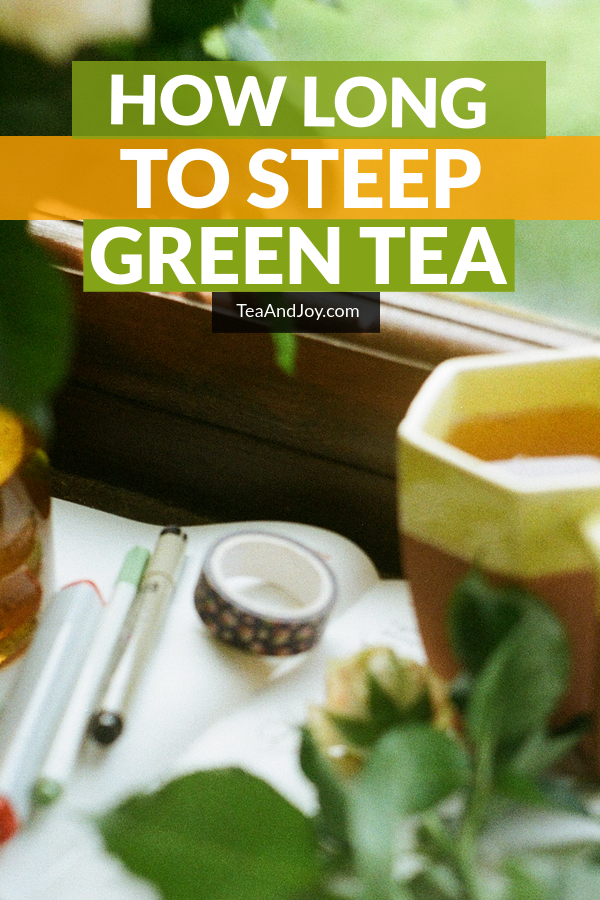Wondering how long to steep green tea? I was too. Turns out, when it comes to making the perfect pot of green tea, timing is everything. Thirty seconds to three minutes are often recommended, but that’s quite a range. To further pin this down, let’s “immerse” ourselves in the subject – yes, I said that lol!
In this article you'll find:
Steeping Time
Alright, so let’s get right to it. Then you can read on for more details to really help you decide. Since thirty seconds to three minutes is a pretty wide range, let’s narrow it down.
Assuming a ratio of 1 teaspoon of loose tea for each 6 ounce cup hot water, and assuming a water temperature of 176° F (80° C), green tea should be steeped as follows:
- Japanese sencha – steep for only 30 seconds in hot (176° F/80° C) water (1-2 minutes for cooler water). Subsequent re-steeping of the same leaves can be up to 3 minutes
- Chinese first harvest tea – steep for 2 minutes in hot water
- Indian or Sri Lankan tea – steep for 2 minutes in medium-temperature water (167° F/75° C)
- Roasted green tea – steep for 1 to 3 minutes in hot to very hot water (176°-194° F/80°-90° C)
So, What Exactly is Steeping?
According to the dictionary, the word “steep,” when used as a verb, means to immerse something in liquid so that you can slowly add to or take away something from it.
In other words, osmosis (for all you science lovers out there).
And I probably should mention (for all you word geeks like me) that steeping is not the same thing as soaking.
Why is this an important distinction? Because to soak something means you’re drenching the poor thing. Steeping has way more finesse than that.
What you’re after is a gradual coaxing of the leaves to release their flavors and nutrients – not too little of them, and not too much.
And exactly what nutrients are we talking about here? Well, there are catechins, tannins, amino acids, and volatiles, just to name a few – the very nutrients that will either make or break (not literally) your cup of green tea.
Origin of the Word “Steep”
I always like to know where words come from. Call me crazy, but I think it helps to know how things were talked about in the old days, especially when it comes to traditions such as making tea.
As far as linguists can tell, the word “steep” (the verb, not the adjective) was first used in the early 1300s. Some think it might have come from the Old Norse word “steypa,” which meant to pour something out.
That makes sense. After all, the whole purpose of steeping is that eventually, you’ll come to the moment you’ve been waiting for: the delicious pour. But please don’t let some historical Norseman confuse you. Steeping and pouring are not the same thing!
My grandmother used to say, “Look before you leap.” The same is true of steeping. It’s important that you are patient, and that you “steep” (for the proper amount of time) before you “steypa.”
What About Brewing?
I have no idea where the word “brew” came from, but not to worry. Brewing and steeping are not the same thing.
Brewing is the entire process of making tea, which includes heating the water, preparing the teapot, adding tea to water (or vice versa in some cases), covering the pot, steeping, straining, and finally pouring. There’s an art and a science to it.
Science?
Yes, it’s a scientific fact that tea leaves are brimming with chemical compounds, including those catechins I mentioned before. So, if you want to know how long to steep green tea, here’s your science lesson for today.
Catechins are antioxidant polyphenols found in tea, berries, and cocoa. The youngest green tea leaves, known as “first harvest,” contain the most catechins. And catechins contribute to tea’s bitter taste.
So, if you’re steeping first harvest green tea, it’s recommended that you use a cooler water temperature and a shorter steep time, to reduce the number of catechins that are released into the water.
More mature tea leaves such as hojicha or bancha can tolerate higher temperatures and longer steeping.
Effects of Steeping Too Long
Green tea leaves are delicate. Steeping them for too long will result in a bitter, astringent flavor. However, the good news is that you can always turn it into iced tea. Adding sweeteners and other flavors, like mint perhaps, will allow you to adjust the flavor to your liking.
Effects of Not Steeping Long Enough
Your tea will be too weak. End of discussion. But hey, if you like that, that’s a-okay. It’s your cup of tea after all.
Tips
Green tea should always be added to the hot water, rather than pouring water over the tea. Remember, we are gently coaxing, not demanding.
Teapots with built-in strainers allow you to pour away to your heart’s content without having to remove tea leaves. Your tea will not become over-steeped that way.
Loose tea can be re-steeped.
Don’t be afraid to experiment. If you don’t like the taste, start over. After all, it’s only water (and a teaspoon of tea), right? Maybe start by steeping for a minute or two, then sip every half minute until you’ve found your sweet spot.
Did Someone Mention Iced Tea?
Oh yes, I did. When making iced green tea, the steeping can be a lot longer since your tea solution will be diluted with ice, and maybe even lemon, sugar, honey, or mint leaves.
What About Cold Brew Green Tea?
Cold brew is another option, especially as a way to keep cool in the summer. And it has another benefit, too: a smoother experience.
The tannins that are released into hot water during the regular steeping process have a certain amount of natural bitterness in them. And then, when hot tea is refrigerated, the tannins become even more bitter.
But by steeping tea at a cooler temperature (namely, cold), fewer tannins are released into the water in the first place, and they don’t continue to get more bitter after they are stored in the fridge.
Et voilà, your cold brew green tea will have achieved maximum smoothness.
How Long To Steep Green Tea – Conclusion
Now that you’ve been steeped in all things steep-related, you should have a pretty good handle on how long to steep your next pot of green tea. While it’s true that the range is thirty seconds to three minutes, there are reasons to lean toward one end of the spectrum or the other – see the top of this article – “Steeping Time” for details.
Thanks for reading. Hopefully, today’s learning curve wasn’t too … ahem … steep.




